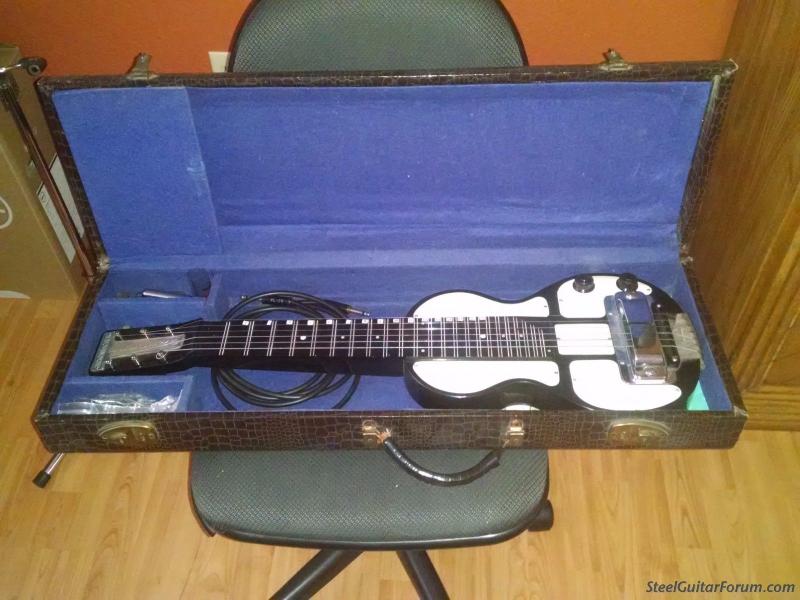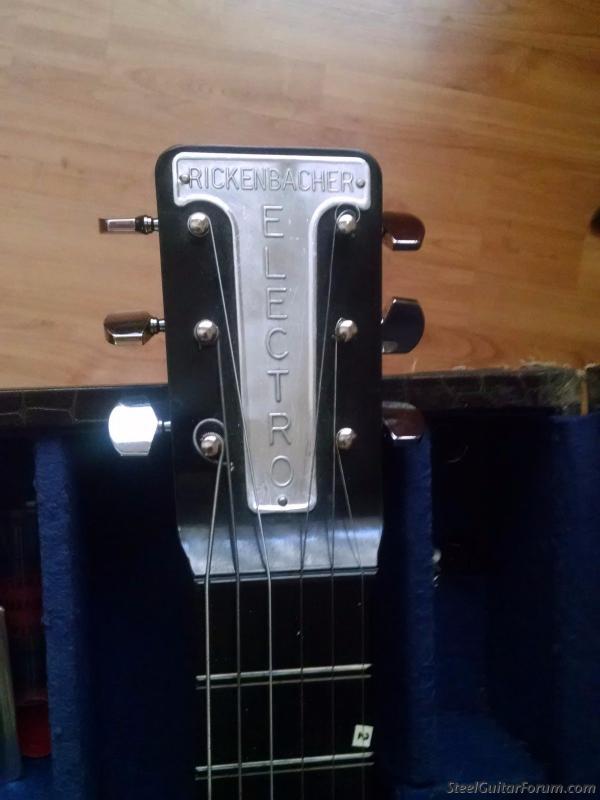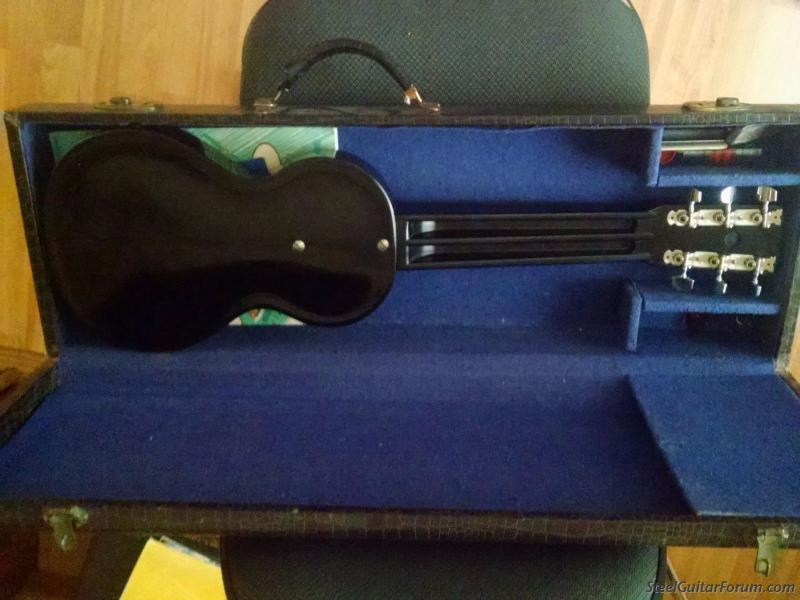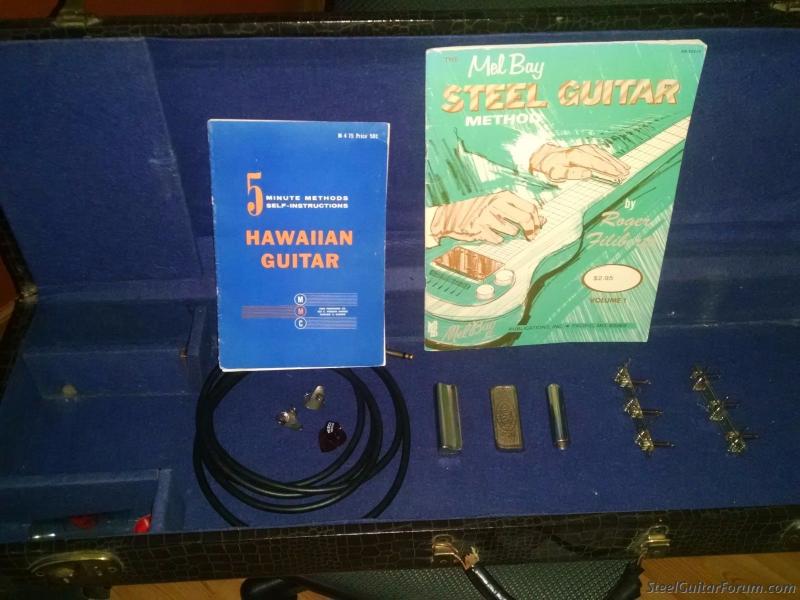| Author |
Topic: RIckenbacher Panda Purchase Questions |
Mark Helm
From:
Tennessee, USA
|
 Posted 21 Oct 2017 11:51 pm
Posted 21 Oct 2017 11:51 pm |
|
Hey, Gang:
I just stayed up REALLY late, bit my nails, went out on a limb and bought this 1940s (I think) Rick Electro. OK... I paid $750 for it--that includes shipping, the admittedly weathered HS case, the old steels, books and picks, etc.
Questions:
*Does it look right to you fellas (It does to me)?
*Any idea if this is a B6, and/or what year it might be?
*Was it worth spending the bulk of the night hunched over in an uncomfortable chair, frittering away $750 of my son's future beer (oops, I meant " college") money on yet another lap steel guitar? Oh, and did I get a good deal?
As always, thanks--you guys rock (and roll...and other stuff, but hey--there could be ladies present!)
Chers,
Mark





_________________
Remington Steelmaster S8 w/ custom Steeltronics pickup. Vox MV-50 amplifier + an 1940's Oahu cab w/ 8" American Vintage speaker. J. Mascis Fender Squire Jazzmaster, Hofner Club bass, Ibanez AVN4-VMS Artwood Vintage Series Concert Size Acoustic Guitar. 1920s/30s Supertone Hawaiian-themed parlor guitar. Silvertone parlor guitar. |
|
|
 |
Erv Niehaus
From:
Litchfield, MN, USA
|
 Posted 22 Oct 2017 6:03 am
Posted 22 Oct 2017 6:03 am |
|
Looks good to me. 
Erv |
|
|
 |
Jack Hanson
From:
San Luis Valley, USA
|
 Posted 22 Oct 2017 6:11 am
Posted 22 Oct 2017 6:11 am |
|
I have the same one except that mine has white flying saucer knobs; I would not sell it for $750.00. That's undoubtedly a B-6 of early postwar vintage. One of the best sounding lap steels ever built by anyone anywhere at any time. It appears to have replacement tuners, but everything else looks original with the exception of those homemade fretboard markers.
By the way, if those old fingerpicks happen to be vintage Nationals, you could possibly recoup a significant portion of your investment by peddling them. |
|
|
 |
Joe Burke
From:
Toronto, Canada
|
 Posted 22 Oct 2017 6:39 am
Posted 22 Oct 2017 6:39 am |
|
| Looks like a beauty to me! |
|
|
 |
Lee Holliday
From:
United Kingdom
|
 Posted 22 Oct 2017 12:46 pm
Posted 22 Oct 2017 12:46 pm |
|
I have one also, great guitars, the tuners look like replacements, and the stickers on the fingerboard should come away with some soapy water.
Yours has the better case than mine which has the guitar shaped case.
Enjoy it and it looks a sound purchase.
Lee
PS I have just seen the old tuners in the image, get some Stew mac ivoroid buttons and refit them. |
|
|
 |
Allen Hutchison
From:
Kilcoy, Qld, Australia
|
 Posted 22 Oct 2017 1:20 pm
Posted 22 Oct 2017 1:20 pm |
|
Looks like you got a great deal to me! 
I would have jumped on that in a trice. Enjoy  |
|
|
 |
Michael Brebes
From:
Northridge CA
|
 Posted 22 Oct 2017 2:26 pm
Posted 22 Oct 2017 2:26 pm |
|
I would agree about the replacement buttons from StewMac. If the gears are in good shape on the old tuners, definitely rebuild them with the new buttons. The tuners that are on there now look usable but not that great. Everthing else on the steel looks great. I have one from about the same time period and it sounds great.
_________________
Michael Brebes
Instrument/amp/ pickup repair
MSA D10 Classic/Rickenbacher B6/
Dickerson MOTS/Dobro D32 Hawaiian/
Goldtone Paul Beard Reso
Mesa Boogie Studio Pre/Hafler 3000
RP1/MPX100 |
|
|
 |
Jim Cohen
From:
Philadelphia, PA
|
 Posted 22 Oct 2017 3:38 pm
Posted 22 Oct 2017 3:38 pm |
|
I had one like it and sold it years ago for about $800, so I'd say you got an excellent deal. (However, mine was a through-the-body model, so my buyer got a good deal!)
_________________
www.JimCohen.com
www.RonstadtRevue.com
www.BeatsWalkin.com
Last edited by Jim Cohen on 23 Oct 2017 2:02 pm; edited 1 time in total |
|
|
 |
Mark Helm
From:
Tennessee, USA
|
 Posted 22 Oct 2017 8:51 pm Thanks, Guys!
Posted 22 Oct 2017 8:51 pm Thanks, Guys! |
|
Thanks for the advice on the tuners, guys! Now I just wait with my fingers crossed it arrives unscathed.
What do you think the date is (roughly) on this? And how can we tell?
_________________
Remington Steelmaster S8 w/ custom Steeltronics pickup. Vox MV-50 amplifier + an 1940's Oahu cab w/ 8" American Vintage speaker. J. Mascis Fender Squire Jazzmaster, Hofner Club bass, Ibanez AVN4-VMS Artwood Vintage Series Concert Size Acoustic Guitar. 1920s/30s Supertone Hawaiian-themed parlor guitar. Silvertone parlor guitar. |
|
|
 |
Erv Niehaus
From:
Litchfield, MN, USA
|
 Posted 23 Oct 2017 7:26 am
Posted 23 Oct 2017 7:26 am |
|
It's not an early model, you can tell because the strings do not go through the body, it has the narrower 1 1/4" pickup, the white lines by the frets and it has the "T" logo.
However it is not a real late model because Rickenbacher is spelled with an h instead of a k.
It is a post war model but not long after the war ended. |
|
|
 |
Allen Hutchison
From:
Kilcoy, Qld, Australia
|
 Posted 23 Oct 2017 2:01 pm
Posted 23 Oct 2017 2:01 pm |
|
What Erv said  However, going by the info below, it could have been from early 1945 - but more likely just after WW2. However, going by the info below, it could have been from early 1945 - but more likely just after WW2.
I collected this info from here, by an author whose name escapes me. I apologize for that, & hope they approve of my repeating it here!
To "best guess" the year a Rick Bakelite steel was made, requires bracketing the earliest and latest years certain features began and certain features ended. I've listed those features and years below.
Some Ric bakelite steels slang:
"Pre-war" = 1933 through 1939.
"War-time" = 1940 through 1944.
"Post-war" = 1945 and thereafter.
YEARS AND FEATURES:
PRE-WAR; (1933 through 1939):
>>> 1 1/2" magnets until 1945.
-- Chromed body plates until 1940.
-- 1933 for an unknown (to me) amount of time, the pickup mounting ear-tabs had no patent info stamped in; But a short time later "Pat. Pending" was stamped into the ear-tabs.
-- One volume knob on treble bout plate until 1937.
-- One tone knob was added on Bass bout plate mid-1937 to 1939.
-- 90 degree-ish body edges (Some Fo-Bros have reported some body edges slightly filed at approx. 45 degree angle), until 1940.
>>> Strings through body until late 1944.
>>> In August 1937 a patent number began being stamped into the ear-tabs.
>>> Thinner under-side neck spars until 1940. (Some thinner necks were used in 1940 until they ran out).
>>> No white outlined frets until 1940.
>>> Small logo plate on headstock until 1944.
WAR-TIME; (1940 through 1944):
-- In 1940 the previous neck with thinner neck spars was replaced by thicker neck spars neck.
>>> (Some thinner necks appeared on some early 1940 steels).
>>> 1940 white body plates began. Most were white painted metal while some were white (celluloid?) plastic. ( Chromed body plates have appeared on some "war-time" Rics).
>>> 1940 white outlined frets began.
>>> 1940 both Vol & Tone knobs on treble bout plate began.
>>> 1940 frets outlined with white paint began. I have seen thinner necks with white outlined frets on early 1940 Rics. My favorite personal steel (early 1940) has thinner neck with white outlined frets.
>>> In 1940 the input jack was moved from players side to audience side.
>>> 1940 the body mold was changed to produce rounded body edges.
Note: When new features were indtroduced into a particular year model, it was common that some previous-model parts were left over and used on steels made early in the next year the new part was "supposed to" be used; For instance, I've seen some thinner necks on Rics made in early 1940 when thicker necks were "supposed to" be normal starting in 1940, ...and my favorite personal steel is early 1940 and has the thinner neck, and even it's frets are outlined in white which began in 1940, ...and I've seen quite a few T-shaped headstock logo plates with RickenbacHer spelling on early 1945 steels, when, officially, RickenbacKer spelling T-logo plates were "supposed to" have begun at the beginning of 1945.
"POST WAR"; (1945 and thereafter):
-- T' shaped headstock logo plate with RickenbacKer spelling.
-- 1 1/4" pickup magnets.
-- Pickup mounted in a chromed bezel that surrounds the pickup magnets and is screwed to the body.
-- Bridge no longer moulded into the body; It's screwed onto the body.
-- Strings no longer go through the body; Their ball-ends are secured into a chromed tailpiece attached to the rear butt of the body similar to jazz guitars, dobros, etc.
-- 1950s saw the headstock logo change to an arrow-head shape with RICKENBACKER spelled within it's borders.
-- The BD model had a hinged "ashtray" lid over the strings side of the headstock.
-- For a short while towards the end of Rics bakelite steels manufacture, Ric reverted back to strings through the body. |
|
|
 |
Bill Creller
From:
Saginaw, Michigan, USA (deceased)
|
 Posted 23 Oct 2017 4:16 pm
Posted 23 Oct 2017 4:16 pm |
|
It's a late 40s model. Looks like a nice one too. I've had two like that, but now have a 7 string of that same era, my 3rd one of those...
Nothing like a Bakelite !!
 |
|
|
 |
Mark Helm
From:
Tennessee, USA
|
 Posted 23 Oct 2017 11:35 pm Don't think it's late 40s?
Posted 23 Oct 2017 11:35 pm Don't think it's late 40s? |
|
Guys: You cats are amazing!
By the info --and thanks for it, friends!!!! -- it can't be too much after 1945, right? As it has a "Rickenbacher" logo with the "H".
And more expert opinion greatly appreciated!
--Mark
_________________
Remington Steelmaster S8 w/ custom Steeltronics pickup. Vox MV-50 amplifier + an 1940's Oahu cab w/ 8" American Vintage speaker. J. Mascis Fender Squire Jazzmaster, Hofner Club bass, Ibanez AVN4-VMS Artwood Vintage Series Concert Size Acoustic Guitar. 1920s/30s Supertone Hawaiian-themed parlor guitar. Silvertone parlor guitar. |
|
|
 |
Dave Mudgett
From:
Central Pennsylvania and Gallatin, Tennessee
|
 Posted 24 Oct 2017 12:17 am
Posted 24 Oct 2017 12:17 am |
|
I agree, post-war B6. If you really want to hone in closer on the manufacturing date, take a look at the EIA code on the potentiometers. If they're original, they should look something like XXXYWW. XXX is the manufacturer code (304 = Stackpole, 137 = CTS, there may be some others, it might be 2 digits instead of 3). Y (could be YY) gives the year of production, and WW gives the week of production. If you only have a single year digit, you need to use the features to narrow down the decade, so on yours, 7 would mean 1947, this isn't a 1957 or 1937. If that EIA code is present (and you can see it - I would NOT unsolder anything just to get a look at it), that should at least give you a lower bound on the year of production - it couldn't have been made before the week/year the pot was made. Sometimes pots sat around a factory before being installed, but generally this gets you in the ballpark.
In terms of value, I don't think the exact date matters at all - it's a nice post-war B6 that looks original except for the replaced tuners. Plenty of vintage dealers barely distinguish between pre-war and post-war models, and certainly don't care about the minutiae of details between various post-war models. As long as the pickup is strong and it sounds good, I think you did great.
There's always some discussion about the relative merits vs. demerits of different periods of these. I think these revolve heavily around the 1-1/4" width pickup on post-war models vs. the 1-1/2" width pickup on earlier ones. A lot of people argue that the wider pickup is somehow 'better'. But I think a lot of this boils down to personal taste. I traded a post-war B6 for an earlier one, and to be honest, I'd just as soon have the post-war back. |
|
|
 |
Mark Helm
From:
Tennessee, USA
|
 Posted 24 Oct 2017 6:28 am Thanks, Dave!
Posted 24 Oct 2017 6:28 am Thanks, Dave! |
|
...and thanks to all you genuine experts. I'm hoping that having a better steel will help my laying a bit. It can be frustrating when, as a relative beginner, problems with an inexpensive steel get in the way of learning.
Any one who has any more info or advice, please bring it on! I'm most grateful.
_________________
Remington Steelmaster S8 w/ custom Steeltronics pickup. Vox MV-50 amplifier + an 1940's Oahu cab w/ 8" American Vintage speaker. J. Mascis Fender Squire Jazzmaster, Hofner Club bass, Ibanez AVN4-VMS Artwood Vintage Series Concert Size Acoustic Guitar. 1920s/30s Supertone Hawaiian-themed parlor guitar. Silvertone parlor guitar. |
|
|
 |
Jack Hanson
From:
San Luis Valley, USA
|
 Posted 24 Oct 2017 6:40 am
Posted 24 Oct 2017 6:40 am |
|
| Dave Mudgett wrote: |
| There's always some discussion about the relative merits vs. demerits of different periods of these. I think these revolve heavily around the 1-1/4" width pickup on post-war models vs. the 1-1/2" width pickup on earlier ones. A lot of people argue that the wider pickup is somehow 'better'. But I think a lot of this boils down to personal taste. |
My bakelite has the 1-1/4" pickup. It's the best-sounding electric guitar I've ever played -- steel, Spanish, or otherwise.
Caveat: Never played a prewar bakelite with the wider pickup. Never played a prewar frypan. But my postwar B-6 sounds good enough that I could never get away with blaming my poor sound on the equipment. It even makes bad amplifiers sound good. |
|
|
 |
John Limbach
From:
Billings, Montana, USA
|
 Posted 24 Oct 2017 9:55 am
Posted 24 Oct 2017 9:55 am |
|
If the pickup needs work, contact Rick Aiello here on the forum. He is the master of magnetics and guru of all things Rick. He's done the pickups on my 1934 A22 Frypan and two post war B6s. If you undo the input plug, you can remove the pickup and electronics in one piece. Stuff it in a box and he'll regauss the magnets and/or rewind or repair the coil as necessary. The tone cap should be replaced as its turned into more of a resistor than cap after all these years. Spray a little DeOxit in the pots and they'll most likely be OK.
I predict that you'll love it. And as others have said, you got a really good deal.
Have fun with it. |
|
|
 |
Allen Hutchison
From:
Kilcoy, Qld, Australia
|
 Posted 24 Oct 2017 1:59 pm
Posted 24 Oct 2017 1:59 pm |
|
I have played, & heard played both 1.5" & 1.25" models, compared through the exact same set up & equipment.
To my ear, I couldn't discern any noticeable difference. They are ALL good!
As Dave said above, most likely any audible difference, would come down to the electronic/s condition.
Happy pickin'  |
|
|
 |
Bill Creller
From:
Saginaw, Michigan, USA (deceased)
|
 Posted 24 Oct 2017 6:22 pm
Posted 24 Oct 2017 6:22 pm |
|
I can't say that I can really tell the difference between the "wide" or "narrow" magnets ! I made a bunch of the "wide" ones, and a few of the "narrow" ones, and never figured out if one type was better !  |
|
|
 |
Jerry Wagner
From:
California, USA
|
 Posted 25 Oct 2017 8:03 am
Posted 25 Oct 2017 8:03 am |
|
’m another big fan of Ric Bakelites and Frypans. I agree about re-fitting the original tuners. They’re probably in good condition and just need new buttons. I’ve got to give a shout out to Bill Creller too; he gave me invaluable advice & help on rebuilding a post WWII Bakelite last year. Mine had a Bakelite bridge, like this one, but it was deeply grooved. I don’t know if it was grooved at the factory, but I don’t favor that kind set-up, because it lowers the action so my picks start contacting the fretboard. I took my Bakelite bridge to a machinist and had him make a stainless steel replica with no grooves. I can’t tell from the photos if your bridge is grooved, but if it is, and the action is too low, you might consider having a replacement made. My new bridge looks similar to the one on this Ric 10 string Bakelite:
www.ebay.com/itm/Vintage-1940-039-s-Rickenbacker-B-10-Ten-String-Lap-Steel-Slide-Hawaiian-Guitar-1949-/282640042492 |
|
|
 |
Mark Helm
From:
Tennessee, USA
|
 Posted 26 Oct 2017 12:36 am Bridge the Model B
Posted 26 Oct 2017 12:36 am Bridge the Model B |
|
Anyone else had issues with the grooves on the bridge?
_________________
Remington Steelmaster S8 w/ custom Steeltronics pickup. Vox MV-50 amplifier + an 1940's Oahu cab w/ 8" American Vintage speaker. J. Mascis Fender Squire Jazzmaster, Hofner Club bass, Ibanez AVN4-VMS Artwood Vintage Series Concert Size Acoustic Guitar. 1920s/30s Supertone Hawaiian-themed parlor guitar. Silvertone parlor guitar. |
|
|
 |
Bill Creller
From:
Saginaw, Michigan, USA (deceased)
|
 Posted 26 Oct 2017 8:13 pm
Posted 26 Oct 2017 8:13 pm |
|
My current 7 string bakelite has a bridge I made of bronze & had chrome plated. I can't say it sounds any better that the original though, and just adds some bling to the looks of the guitar !! 
And it has no grooves... |
|
|
 |
Erv Niehaus
From:
Litchfield, MN, USA
|
 Posted 27 Oct 2017 6:59 am
Posted 27 Oct 2017 6:59 am |
|
Mark,
I've heard of those who have filled in the string grooves with black epoxy and then re-filed them.
You can get black epoxy at www.stewmac.com
Erv |
|
|
 |
Jerry Wagner
From:
California, USA
|
 Posted 27 Oct 2017 3:49 pm
Posted 27 Oct 2017 3:49 pm |
|
| Erv's suggestion is good, and would cost a lot less than having a machinist make a new bridge. Bill says the tone's much the same, and he would know. But you should probably just play it for a while and see if the bridge grooves lower the action enough so your picks contact the fret board a lot. If your bridge grooves are shallow, like those at the nut, it's probably not a problem at all. My bridge had really deep grooves; not good! |
|
|
 |
Erv Niehaus
From:
Litchfield, MN, USA
|
 Posted 30 Oct 2017 8:21 am
Posted 30 Oct 2017 8:21 am |
|
You could always get one of those gizmos that converts a regular guitar into a steel guitar. They fit over the nut and raise the strings off the fretboard.
I bought an old Oahu guitar that someone filed down the nut so they could fret it and I put one of those deals on that guitar, works fine. 
Erv |
|
|
 |




